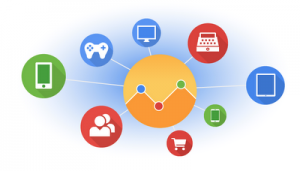Universal Analytics (UA) is fully implemented in some institutions.
Same for Google Tag Manager (GTM) – which is basically a solution to manage all the differents tags used to track your campaigns or online advertising. GTM is a very good news for marketers, because it enables them to manage this part without bothering the web folks or spending too much time looking at code :-)
I spent a lot of time researching UA and GTM to write my March 2014 Internet Technologies column for University Business. I talked to a few analytics professionals inside and outside of our industry.
 Stephane Hamel, Director of Innovation for Cardinal Path – one of the top analytics consultancies in the world – also teaches digital analytics at Laval University. Some of you might remember his master class on social media analytics – it was big hit!
Stephane Hamel, Director of Innovation for Cardinal Path – one of the top analytics consultancies in the world – also teaches digital analytics at Laval University. Some of you might remember his master class on social media analytics – it was big hit!
Stephane was kind enough to answer my questions about Universal Analytics and GTM despite his busy schedule, so we can all better understand the challenges and opportunities these new tools will bring to universities and colleges.
What is the main difference between Google Analytics and Universal Analytics? Why should higher ed institutions care?
On the surface, Universal Analytics (UA) will continue to work as before and provide insight about where your visitors are coming from, what they are doing on your website, and if they were successful in completing one of your business goal. Behind the hood, however, UA is a totally reengineered analytics platform that expand capabilities to an unprecedented level. For higher-ed institutions I see three main areas where UA has the potential to redefine how insight is gained:
- First, probably the most significant change is a shift from “visitors and visits†to “users across devices†– that is, once you can authentify a user (such as when logging to a student portal or using a mobile application where they identified themselves), you can gain a single view of your students.
- Second, UA’s prowess in extending dimensions and metrics means you can add your own attributes to most of the hundreds of existing dimensions. For example, you could add meta-info about programs and courses to reveal affinities; attach visitor interest attributes to gain greater insight about those engaging or not; or conduct advanced cohort analysis to understand the factors leading to students dropping from a program.
- Third, with UA comes the “measurement protocolâ€, a clearly defined syntax which can be used by any connected device to send data to Google. We are leaving the realm of “web analytics†to enter one where Google’s powerful infrastructure can be leveraged to collect and analyse all kind of data.
Do you recommend Google Tag Manager to implement the change to futureproof an implementation? Shouldn’t we wait for the automatic update to Universal Analytics?
 A Tag Management System (TMS) is to tags what a Content Management System (CMS) is to a website. Google Tag Manager (GTM) is a powerful TMS built specifically to facilitate the deployment, management and governance of website instrumentation through tags. Essentially, GTM allows you to clearly define roles and responsibilities and develop specific skills by detaching the web development cycle from instrumentation requirements. Don’t be lured: “easier†doesn’t mean “easyâ€. Proper instrumentation, especially if you want to leverage advanced features, is a unique combination of web front-end development technical skills, intimate understanding of your website functional features and content architecture, and thorough understanding of Universal Analytics tagging…
A Tag Management System (TMS) is to tags what a Content Management System (CMS) is to a website. Google Tag Manager (GTM) is a powerful TMS built specifically to facilitate the deployment, management and governance of website instrumentation through tags. Essentially, GTM allows you to clearly define roles and responsibilities and develop specific skills by detaching the web development cycle from instrumentation requirements. Don’t be lured: “easier†doesn’t mean “easyâ€. Proper instrumentation, especially if you want to leverage advanced features, is a unique combination of web front-end development technical skills, intimate understanding of your website functional features and content architecture, and thorough understanding of Universal Analytics tagging…
Universal Analytics is still in beta, available to those who wishes to get an early start with it. Google is planning a transition period where UA data collection back-end will be backward compatible with existing tags. However, eventually, the “old†tags won’t work anymore and everyone will have to re-tag. But that’s at least two years down the road and I’m convinced you will want to leverage Universal Analytics capabilities well before that.
Ultimately, since you are going to retag your site one day, better do it with Google Tag Manager.
The possibility to track and measure offline interactions looks exciting. How could it be used by institutions of higher education?
 At Cardinal Path, virtually every client work with is at a stage of digital analytics maturity where they want to merge online and offline data. In an era where the term “Big Data†is overused, a down to earth approach of taking full advantage of existing data is a sound approach. This insight can obviously enlighten your online strategy, but ultimately, merging online and offline data is about optimizing the business. The measurement protocol can be used to enrich Universal Analytics with back-office data (or, conversely, the powerful GA Reporting API can bring online data into your back-office system).
At Cardinal Path, virtually every client work with is at a stage of digital analytics maturity where they want to merge online and offline data. In an era where the term “Big Data†is overused, a down to earth approach of taking full advantage of existing data is a sound approach. This insight can obviously enlighten your online strategy, but ultimately, merging online and offline data is about optimizing the business. The measurement protocol can be used to enrich Universal Analytics with back-office data (or, conversely, the powerful GA Reporting API can bring online data into your back-office system).
Another angle to the measurement protocol is in the area of devices ubiquitous connectivity. Google’s chairman Eric Schmidt was quoted saying the recent purchase of Nest thermostat manufacturer will lead to “infinitely more intelligent, and infinitely more useable†technology. Real-time fitness trackers or tiny self-powered GPS trackers are just some examples of how ubiquitous technology can be leveraged to collect useful data.
Integrating employee keycards and lot by learning more about commuters using public transit are two actual examples being looked at. For higher-ed institutions, students cards are often scanned when labs, library or sporting resources are used. The key point is to maintain the balance between a desire to “know it all†and respecting individuals right to privacy. In the long run, ethics and transparency still trumps any data strategy.




RT @karinejoly: #HigherEd Analytics Back-to-School: Why get up-to-speed with Universal Analytics & Google Tag Manager http://t.co/NNBXONuIxx
#HigherEd Analytics Back-to-School: Why get up-to-speed with Universal Analytics & Google Tag Manager http://t.co/Pb4RmKYTCi